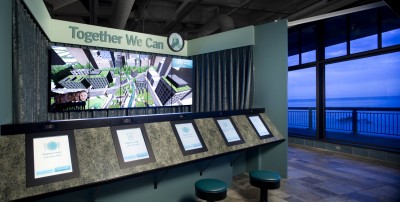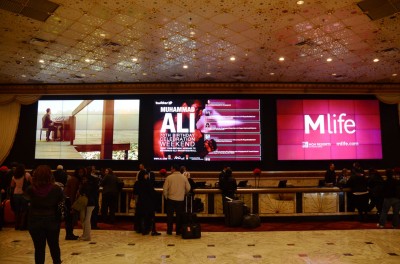Video walls
Technology continues to provide innovative ideas and designs for the large-format digital signage industry. New ultra-narrow bezels, for example, are driving the adoption of larger video wall systems in public spaces, by allowing standard 1.2-m (46-in.) or larger LCDs to be ‘tiled’ into one massive display.
In turn, this is affecting the digital projection market, too. Instead of large retail venues using high-brightness projectors to display images on blank spaces, they are looking to build video walls.

Video walls were too expensive a few years ago for many of the same venues that are implementing them today.
Less than a decade ago, video walls were too expensive for most retailers, restaurant owners and other venue managers to justify implementing. Now these same vertical markets are deploying video walls throughout many locations. The investment has not only become more cost-beneficial, but also given them more of what they want, with the narrower bezels meaning less visual interruption of the displayed images.
Further, video walls lend themselves to be used not simply for retailers’ signage applications, but also for atmospheric purposes. One outdoor recreation store, by way of example, has installed a video wall so the interior décor can be revamped at a whim, rather than having to pay repeatedly to paint and repaint the building’s walls and/or tear down and move merchandising fixtures back and forth. So, adopting this strategy potentially represents huge cost savings for the retailer.
LED-backlit LCDs
In the past, LCDs have typically used cold-cathode fluorescent lamps (CCFLs) for backlighting. A more recent technological has been the introduction of LED-backlit LCDs, which are generally thinner in terms of depth. While they are simply LCDs with a different backlighting configuration, these are now becoming increasingly popular. They are not a mature technology and have not yet achieved the same level of market saturation as CCFLs.
Indeed, the market potential for LED-backlit LCDs remains debatable, but if the technology can deliver on its promise of lower power consumption, longer lifespan and better contrast ratio, it will have significant benefits for users and there is a good chance it will become the predominate technology in the market in the years to come.
So far, market research supports this assessment. According to consulting firm DisplaySearch’s Quarterly Large-Area TFT LCD Shipment Report, 100 per cent of the commercial displays sold through channel sales in the first quarter of 2010 used CCFL backlighting, but by the fourth quarter of 2011, 16 percent of units sold used LED backlighting.
Meanwhile, market research firm iSuppli’s Worldwide Signage & Professional Displays Q4 2011 Market Tracker illustrated customers’ growing interest in video walls. The report estimated the North American market for LED-backlit video walls would increase by 18 percent in 2012 and then nearly double by 2015, seeing solid double-digit growth year-over-year. The retail and outdoor segments were expected to be the heaviest investors in LED backlighting technology this year.






